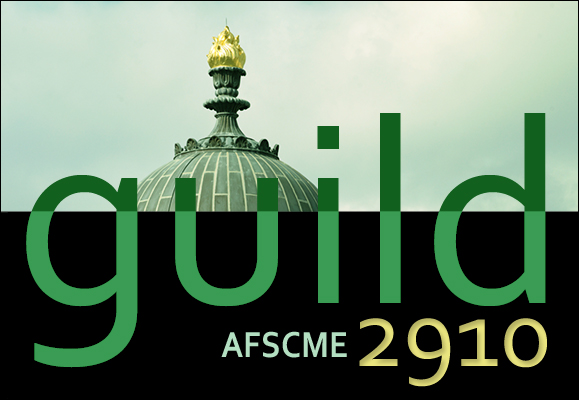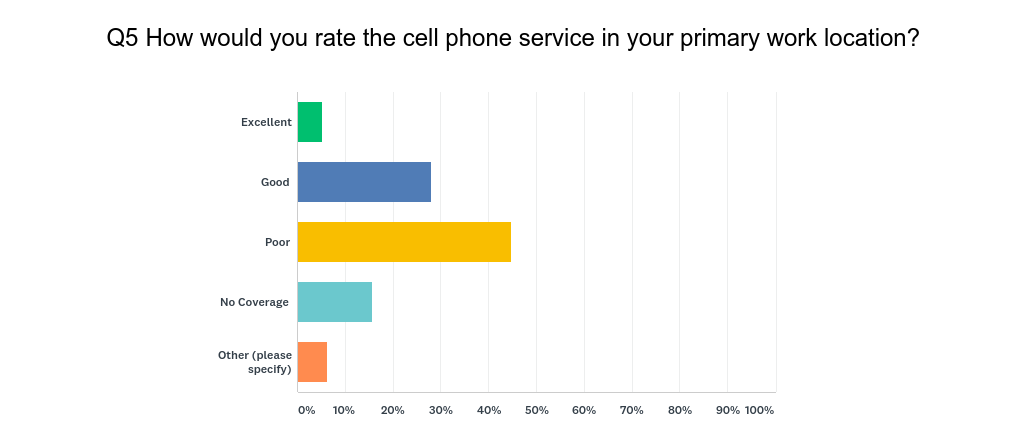From June 12th to July 10th, 2018, the Guild conducted a Cell Phone Service and WiFi Coverage Survey of its bargaining unit employees, who were asked to assess their experiences accessing cell phone service and WiFi signals within Library of Congress buildings.
Background
Concern over the lack of reliable cell phone coverage in Library buildings has been consistently raised by staff within and beyond the Guild’s bargaining unit. The Guild Executive Board (E-Board) felt this was an important issue to focus on because it affects not only employees but also members of the public and Congressional staff—directly impacting their experience as users of the Library.
As a society we have become increasingly reliant on mobile communication, such that on any give day, colleagues, friends, and family members alike assume easy access to Library staff and visitors via their cell phones. Beyond the simple inconvenience caused by lack of consistent coverage inside the Library, delayed or missed phone calls, texts, or voicemail messages can have negative consequences ranging from complications in daily work flows to causing or intensifying stressful family emergencies. Daily life at the Library of Congress is directly affected by inconsistent cell phone coverage, and not always in ways that can be anticipated, or mitigated.
Survey
Using SurveyMonkey, a popular cloud-based survey tool, the E-Board created a set of ten basic questions (see Appendix, below) about cell phone signal and WiFi coverage, which were sent as a link via email to the Guild’s approximately 1350 bargaining unit employees of the Library. Responses to the survey were anonymous. In the month that this voluntary survey was open to Library staff, the Guild received 484 responses, representing roughly 35% of its bargaining unit staff.
Results
- Of those who responded, 86% indicated that they had smartphones, 4% had basic mobile phones, 1% had Library‐issued smartphones, 6% had both personal and library‐ issued smartphone, and 1% had no phone at all.
- Overwhelmingly, respondents to the survey work in the Madison Building, at 68%, followed by the Adams at 13%, Jefferson at 7 %, Taylor Street Annex at 4% and Packard Campus at 5%.
- 45% of those who responded consider cell phone service in their primary work location to be poor, along with an additional 15% who indicated that they have no coverage at all, for a combined 60% with poor or no coverage. This is in contrast with 27% percent who felt that they have good coverage and 5% excellent coverage.
- 55% rated cell phone coverage they encounter throughout the Library—outside of their immediate workspaces—as poor, with 6% indicating no coverage at all, for a combined total of 61% reporting poor or no coverage. That is in contrast with the 19% that rated coverage as good.
- WiFi coverage in primary workspaces was rated as 45% good and 11% excellent, with 30% poor and 6% no coverage.
- Outside of primary workspaces, WiFi coverage was rated as 40% poor, 5 % no coverage, with 36% rating it good and 2% excellent.
- In addition, via the last two questions of the survey the Guild obtained a plethora of specific user experiences with cellphone and WiFi service that could also be utilized in finding solutions to the issue.
Please feel free to visit the Guild Office in LM‐G41, if you would like to peruse the survey results more closely including 268 individual responses for Question 9 (asking for specific anecdotes about public spaces) and the 274 for Question 10 (asking for additional specific anecdotes or observations).
Recommendations
A long-term strategy to establish reliable cellphone service and WiFi coverage is clearly needed at the Library. But in the immediate short‐term, the Guild recommends identification of reliable cellphone and WiFi hotspots in each Library building.
Perhaps the creation of specific spaces – such as the Madison Atrium, for example ‐ where reliable cellphone and WiFi access would be set up and advertised for staff use during break times and lunch. Given our wide membership base (including staff in OCIO), the Guild can assist the Library in identifying ways to address the issue. Connectivity is a key to access in our digital age, and as a general condition of employment, the ability to make and receive phone calls and text messages is an important one. The need to be connected to loved ones during emergencies, the problem of consistently dropped calls, or of being unable to connect to a healthcare provider, are all examples of the immediacy of the issue for Library staff.
These results were provided to Dr. Hayden at a President’s meeting with the Librarian, on July 11, 2018.
Appendix
The ten questions asked in theCell Phone Service and WiFi Coverage Survey were:
- What type of cell phone do you use?
- Which Library of Congress building do you work in?
- Which floor of that building is your primary work location?
- Which cell phone carrier do you use?
- How would you rate the cell phone service in your primary work location?
- If you spend time in other parts of your building or the Library, how do you generally rate the cellphone service you encounter throughout the day?
- How would you rate the Library’s WiFi coverage in your primary work location?
- If you spend time in other parts of your building or the Library, how do you generally rate the Library’s WiFi coverage you encounter throughout the day.
- If you have noticed any issues with cellphone service or WiFi coverage in public Library spaces (i.e. Reading Rooms, Corridors, Snack Bars, Cafeterias, Rest Rooms) or have heard from the public regarding their experiences, please note what you’ve encountered or heard and where it has occurred – in the space below.
- Please share any stories or anecdotes that illustrate your overall experiences withcell phone service or WiFi coverage at the Library in the space below.

